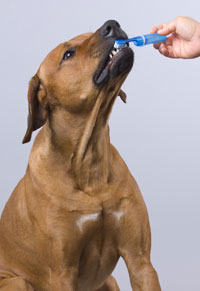
Dental disease is the most common disease in dogs and cats, even though you may be unaware that your pet is suffering from it. Over 68% of all pets over the age of three have some form of periodontal or dental disease. Most pets will show few symptoms. It is up to the pets family and veterinarian to uncover this hidden and often painful condition. Dental problems in pets are different from those in humans. In man the most common problem is tooth decay which, due to the loss of calcium from the enamel, results in painful, infected cavities. In pets, tooth decay represents less than 10% of all dental problems. The most common dental problems seen in pets are caused by periodontal disease.
Periodontal disease is a term used to describe inflammation or infection of the tissues surrounding the tooth. Accumulation of tartar and calculus on the teeth contributes to gum recession around the base of the tooth. Infection soon follows and the gums recede, exposing sensitive unprotected tooth surfaces. Untreated infection then spreads into the tooth socket and ultimately the tooth loosens and is lost.
The mouth of all mammals is home to thousands of bacteria. Many of these bacteria will breed on the surfaces of the tooth and form an invisible layer called plaque or biofilm. Some of this is removed naturally by the pets tongue and chewing habits, but if allowed to remain on the tooth surface, the plaque thickens, becomes mineralized, and then is visible as tartar and ultimately calculus. The tartar presses on the gums, which recede, causing inflammation and infection called gingivitis. The gums continue to recede until ultimately the tooth socket is infected and the tooth is lost. As the oral infection increases, tonsillitis and pharyngitis can also occur. In addition, the bacteria are absorbed into the bloodstream and can be carried to other organs. Heart valve infections(endocardiosis or endocarditis), kidney and liver problems are frequently caused by “bad teeth.”
Plaque becomes mineralized in some pets much quicker than in others. Specialized canine and feline products as well as feeding specifically-formulated dental diets may help reduce tartar build up, as does regular home care such as tooth brushing. Today there are many products designed to reduce tartar in our pets. Once tartar has been formed it will be necessary to remove it by professional scaling and polishing under anaesthesia. Pet food manufacturers have recently developed new dental diets that can help reduce the formation of plaque and tartar in your pet.
Comprehensive Dentistry
The goal of dental scaling and polishing is to remove the tartar and invisible plaque. We will perform pre-anaesthetic blood tests(if you have chosen to do so) to ensure that kidney and liver function are satisfactory for anesthesia. We also recommend intravenous fluids be given during and after the dentistry to provide a more stable anaethesia and quicker recovery. Sometimes antibiotic treatment is instituted before a full dental prophylaxis is carried out. Tooth scaling will be performed using both hand scalers and ultrasonic cleaning equipment to remove tartar both above and below the gum line. The tartar beneath the gum line causes the most significant gum recession. The teeth are then polished in order to help prevent subsequent plaque build-up. It may be necessary to carry out other procedures such as extractions at the same time. Special applications such as fluoride, antibiotic preparations and cleaning compounds may be indicated to decrease tooth sensitivity, strengthen enamel and reduce plaque accumulation and bacterial infection. These procedures will be fully discussed both before your pets dental cleaning and when you bring in your pet for the procedure. Since it can be difficult to predict the extent of dental disease in advance of the procedure, it is imperative that we are able to reach you during the procedure to discuss any additional treatment that may be necessary.
In general, complications are rare during a dentistry. With modern anaesthetics and monitoring equipment, the risk is very low. However, as with all surgical procedures, there is always a small risk:
Anaesthetic Complication– It is always possible that any pet could have an adverse reaction following the administration of any drug. Such cases are impossible to predict, but fortunately are extremely rare. Pre-operative bloodwork is a useful screening test that may detect pre-existing problems which could interfere with the pets ability to handle anaesthetic drugs. We also recomend intravenous fluids be given during and after the dentistry to provide a more stable anaethesia and quicker recovery. It is important that you properly fast your pet prior to surgery according to our instructions. In addition, any signs of illness or previous medical history should be reported to us prior to any sedation, anaesthesia or surgery.
In the vast majority of cases, there are absolutely no adverse affects following a dentistry.
Plaque and tartar begin forming in as little as six hours after your pets dental cleaning. A home dental care program is a must for all pets. We can provide you with instructions on how to brush or rinse your pets teeth. Human dentifrice or toothpaste should not be used for pets. These are foaming products and are not meant to be swallowed. Additionally, many types of human toothpaste contain sodium, which may cause problems in some pets. We sell different flavours of animal toothpastes here.
We will provide you with home care instructions when you come to pick up your pet. If you have any questions about the procedure, please do not hesitate to contact us.


